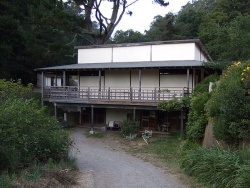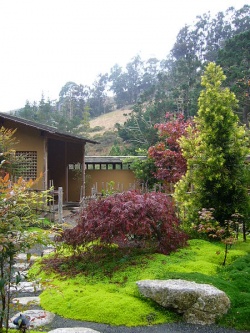Green Gulch Farm Zen Center
Green Gulch Farm Zen Center, or Soryu-ji (meaning Green Dragon Temple) is a Soto Zen practice center located near Muir Beach, California that practices in the lineage of Shunryu Suzuki. In addition to its Zen training program, the center also manages an organic farm and gardens. Founded in 1972 by the San Francisco Zen Center and Zentatsu Richard Baker, the site is located on 115 acres (0.47 km2) in a valley seventeen miles (27 km) north of San Francisco and offers a variety of workshops and classes throughout the year. The land is an inholding of the Golden Gate National Recreation Area and has much wildlife within its borders. In addition to meditation retreats, offerings include classes and workshops on the Japanese tea ceremony and gardening. While Green Gulch Farm has a residential monastery and retreat center, guest house, and conference center, it has also become recognized as a place where organic farmers can come to learn the tools of their trade. One of the original architects of the gardens at Green Gulch was the renowned late horticulturist Alan Chadwick—who had introduced the biodynamic farming techniques influenced by Rudolf Steiner on the farm. Chadwick's grave is marked by a stupa on site. Author Fenton Johnson writes that Green Gulch Farm, "...serve[s] as a model for living on the land in the context of a Zen Buddhist practice."
History
Before his death in 1971, Shunryu Suzuki had asked that his sole Dharma heir—Zentatsu Richard Baker—look for a farm near the San Francisco Bay area where a lay community of practitioners could live amongst one another. When Baker had found just such a place at Green Gulch Farm, some members of the San Francisco Zen Center were hesitant to commit themselves initially to such an endeavor. But Baker saw the area as a place for communal living, where entire families could come together and live as they practiced Zen Buddhism together. So, in the spring of 1972, the farm area was purchased from rancher George Wheelwright (a co-founder of Polaroid). Part of the agreement attached to this sale was the San Francisco Zen Center's commitment to Wheelwright that it would always remain open to the public and engage in agricultural awareness. Community members quickly held various fundraising efforts and constructed their new community, converting a hay barn into the zendo, caring for the land, and building houses.
Green Gulch is particularly concerned with the effects that human beings are having on nature. They hold the philosophy that humans need to protect the environment from us, not the other way around. They do this with religious texts as the basis of such philosophy. Architect Sim Van der Ryn created his first composting toilet for Green Gulch Farm in 1974, built by David Chadwick and Ken Sawyer. Stuart Cowan writes, "The first composter was built in a house at Green Gulch Farm, a Buddhist retreat in nearby Marin County. Soon Sim's neighbor built one, and people started calling for plans. The virtues of the system were that it saved ten to fifteen thousand gallons of water that otherwise would disappear down the toilet each year; it reduced the need for large leach fields, and it literally made people responsible for their own shit, an idea that was attractive to libertarians, organic purists, outlaw builders, and people engaged in reexamining and redesigning all aspects of their daily lives."
Green Gulch operates, in addition to the Zen center, a 7 or 8-acre (32,000 m2) organic vegetable farm and a 1 to 1.5-acre (6,100 m2) fruit, herb and flower garden. The fruit, herb and flower garden is, "arranged in a series of 'rooms' in the formal English style. In the bowl of the valley is the core of the gardens: an herbal circle of shrubs, roses and perennials, enclosed by a yew hedge with rose arbors and paths out to the larger garden. At the center of the circle is a Japanese snowbell (Styrax japonica) encircled by herbs and lichen-covered rocks." The garden is open daily from 9:00 a.m. to 4:00 p.m., though groups of more than six should call before arriving. Volunteers, also, are welcome to help cultivate the garden on Tuesdays from 9:00 a.m. to 12:00 p.m. (again, call in advance). The vegetable farm sustains the community living at Green Gulch and also sells its produce at various local farmers markets and to whole foods stores. Green Gulch Farm also provides organic produce from the vegetable farm around the year to Greens Restaurant in San Francisco, a vegetarian restaurant where Annie Somerville is executive chef.
Every Sunday Green Gulch opens to the public, beginning with zazen at 8:15 a.m., followed by a lecture at 10:15 a.m., tea at 11:15 a.m., and finally lunch at 12:45 p.m. (donations are suggested for these events). The Green Gulch nursery and garden are open seven days a week, and throughout the year many classes are offered on gardening, pruning, flower arrangement and herb culture. Admission is free, though parking space is limited and a fee is associated unless your car has three or more occupants. During the summer Green Gulch also offers an apprenticeship program for those interested in becoming organic farmers. Carmen Yuen writes, "The apprentices put nonviolence and mindfulness into action as they work. When digging the soil, they are careful not to expose the worms and split them in half—even if they will regenerate!" Guest houses include the Lindisfarne Guest House and the Wheelright Center. Lindisfarne is in the shape of an octagon, complete with twelve rooms, six baths and an atrium with a woodburning stove where guests can come to read or for conversation; Lindisfarne's kitchen offers its guests tea and snacks. For larger families, the Wheelwright Center has larger living areas for families and a suite equipped with a kitchen. At the Mountain Gate Study Center, classes in Buddhist practice and philosophy are offered.
As of 2006, Green Gulch Farm plans to team up with the National Park Service to help restore Muir Beach to its original beauty. They will apparently remove the parking lot area — which was originally wetlands — in order to restore the area to its original condition. Additionally, author Andrew Ferguson was inspired to write the book Zen's Chinese Heritage: The Masters and Their Teachings by having attended public koan classes offered at Green Gulch Farm. He has written, "For many years, Tenshin Reb Anderson has offered a 'Monday night class' on Thomas Cleary's translation of the Book of Serenity for the benefit of his students and other serious participants. In the manner of the Zen ancients, Tenshin has raised the ancient cases for public viewing. This is a style of Zen practice whereby students may realize their own personal understandings, and then set them forth for others to see, to taste, and to test."
Resident teachers
- Myogen Steve Stücky
- Tenshin Reb Anderson
- Jiko Linda Cutts
- Meiya Wender
- Furyu Nancy Schroeder
- Carolyn Cavanagh
- Luminous Owl Henkel
- Daigan Lueck
- Shinko Rick Slone
- Mick Sopko
- Wendy Johnson - gardener emeritus

